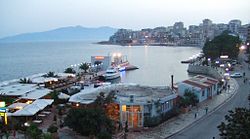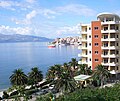→Demographics: grrrr |
Sarandioti (talk | contribs) sources unreliable, official demographics show totally different things. I am Sarandiot and I can tell you that if you come and raise a greek flag in our town, you will see "how" warm our "welcome" will be. |
||
| Line 117: | Line 117: | ||
== Demographics == |
== Demographics == |
||
The population of Saranda increased from 15,700 inhabitants in 1989 to 27,553 in 2001. However, due to uncontrolled movements, especially after 1997, this figure is considered to be even higher. According to municipal sources, approximately 32,000 inhabitants are currently living in the city. |
|||
The population of Saranda increased from 15,700 inhabitants in 1989 to 27,553 in 2001. However, due to uncontrolled movements, especially after 1997, this figure is considered to be even higher. According to municipal sources, approximately 32,000 inhabitants are currently living in the city. Saranda is home to a large Greek minority and is considered, together with [[Gjirokastër]], one of the centers of the [[Greek minority in Albania]]. <ref>[http://www.da.mod.uk/colleges/arag/document-listings/balkan/G97/view?searchterm=greek%20minority%20in%20Albania Pettifer, James. ''The Greek Minority in Albania - In the Aftermath of Communism.'' Conflict Studies Research Center, July 2001, ISBN 1-903584-35-3] - p. 11, "In 1991, Greek shops were attacked in the coastal town of Saranda, home to a large minority population, and inter-ethnic relations throughout Albania worsened."</ref><ref>[http://www.da.mod.uk/colleges/arag/document-listings/balkan/G97/view?searchterm=greek%20minority%20in%20Albania Pettifer, James. ''The Greek Minority in Albania - In the Aftermath of Communism.'' Conflict Studies Research Center, July 2001, ISBN 1-903584-35-3] - p. 12, "The concentration of ethnic Greeks in and around centres of Hellenism such as Saranda and Gjirokastra could guarantee their election there, but nowhere else in the country is success for an Omonia-based candidate possible."</ref><ref>[http://books.google.com/books?id=MkmGHvI-RyUC&pg=PA105&dq=greek+minority+albania&lr=&as_drrb_is=q&as_minm_is=0&as_miny_is=&as_maxm_is=0&as_maxy_is=&as_brr=0''Human rights in post-communist Albania'', Fred Abrahams, Human Rights Watch, p.119] "The town of Saranda has an ethnic Greek population large enough to warrant a school, but one still does not exist".</ref> |
|||
== Notable Inhabitants == |
== Notable Inhabitants == |
||
Revision as of 06:41, 9 June 2009
39°52′N 20°00′E / 39.867°N 20.000°E
Sarandë
Sarandë / Saranda | |
|---|---|
City | |
 | |
| Country | |
| County | Vlorë County |
| District | Sarandë District |
| Government | |
| • Mayor | Edmond Gjoka (PD) |
| Elevation | 0 m (0 ft) |
| Population (2002) | |
| • Total | 15,259[2] |
| Time zone | UTC+1 (Central European Time) |
| • Summer (DST) | UTC+2 (CEST) |
| Postal code | 9701-9703 |
| Area code | +355 (0) 85 |
| Car Plates | SR |
Sarandë or Saranda (Greek: Άγιοι Σαράντα, Agioi Saranda), is the capital of the District of Sarandë, Albania, and is one of the most important tourist attractions of the Albanian Riviera; which the The Guardian argued: "Is set to become the new 'undiscovered gem' of the overcrowded Med."[1] It is situated on an open sea gulf of the Ionian Sea in the Mediterranean, 2 nautical miles from the Greek island of Corfu. The city of Saranda has a population of about 32,000 inhabitants (2008 estimate). Near Sarandë are the remains of the ancient city of Butrint, a UNESCO World Heritage site.
History
Sarandë is build on the ruins of the ancient Greek city of Onchesmos (or Anchiasmos) [2][3][4] and it was inhabited by the Greek[5] tribe of Chaonians. In Roman times Onchesmos flourished as an important port for the trade between the Chaonian capital of Phoenice in Epirus[6][7] and Italia, until 552 CE when it experienced enormous distraction due to repeated attacks from the Goths.
Its current name comes from the name of the Byzantine monastery of the Άγιοι Σαράντα (Agioi Saranta) literally meaning "Forty Saints" in Greek, after the Forty Martyrs of Sebaste, traditionally commemorated by the Orthodox Church on 10 March.
The town (at that time a small village, of approximately 150 inhabitants) was included under the newly formed Albanian state, in 1913. It was occupied twice by Greece in 1913 and 1914-1916, by Greek insurgents of the Autonomous Republic of Northern Epirus in 1914 and by Italy (1916-1920)[8]. Saranda was again occupied in 1939 by Italian forces and it was used as the vital port for the fascist forces of Italy. It was then temporarily called "Porto Edda" in honor of Edda Mussolini, the eldest daughter of Benito Mussolini, during when Albania was annexed to Italy. During the Greco-Italian War the Greeks occupied a large area of southern Albania (called "Northern Epirus" by the Greeks) and the city came under Greek rule in 6 December 1940 for a short period of time before the German invasion in Greece and the consequent withdraw of the Greek army.
Economy
The sea panorama, the variety of flora, as well as the soft Mediterranean climate, are among the things that make Saranda the preferred recreational center, and an important tourist attraction. The number of couples who arrange to spend their honeymoon in Sarandë is impressive. Therefore, it shouldn't be surprising that Saranda is known as the honeymooners' city. Over the last two decades, Saranda has become the preferred tourist destination. Tourism is the major economic resource, while other resources include services, fishery and construction. The unemployment rate according to the population census of 2008 was 8.32%. It is suggested that family tourism, and seasonal work during the summer period, dramatically mitigate the unemployment rate.
Demographics
The population of Saranda increased from 15,700 inhabitants in 1989 to 27,553 in 2001. However, due to uncontrolled movements, especially after 1997, this figure is considered to be even higher. According to municipal sources, approximately 32,000 inhabitants are currently living in the city.
Notable Inhabitants
- Naim Frashëri, national poet of Albania lived in the city for 3 years.[9]
Gallery
References
- ^ [1] 2009's hot new beach destination: Albania, www.guardian.co.uk
- ^ Strabo, The Geography, Book VII, Chapter 7.5: "...these mountains one comes to Onchesmus, another harbor, opposite which lie the western extremities of Corcyraea."
- ^ Bowden, William. Epirus Vetus: The Archaeology of a Late Antique Province. London: Duckworth, 2003, ISBN 0715631160, p. 14. "Anchiasmos (Onchesmos)"
- ^ Hodges, Richard. Saranda - Ancient Onchesmos: A Short History and Guide. Butrint Foundation, 2007. ISBN 9994394363
- ^ Hammond, N.G.L. Philip of Macedon. London, UK: Duckworth, 1994. "Epirus was a land of milk and animal products...The social unit was a small tribe, consisting of several nomadic or semi-nomadic groups, and these tribes, of which more than seventy names are known, coalesced into large tribal coalitions, three in number: Thesprotians, Molossians and Chaonians...We know from the discovery of inscriptions that these tribes were speaking the Greek language (in a West-Greek dialect)."
- ^ Talbert, Richard J.A. and Bagnall, Roger S. Barrington Atlas of the Greek and Roman World, 2000, p. 815. "harbor, cape or town in Epirus between Onchesmos and Bouthroton."
- ^ Eidinow, Esther. Oracles, Curses, and Risk Among the Ancient Greeks. Oxford University Press, 2007. ISBN 0199277788 "Onchesmos was the principal port of Phoinike, the capital of Chaonia,..."
- ^ Edith Pierpont Stickney. Southern Albania or northern Epirus in European international affairs, 1912-1923 Stanford university press, 1926.
- ^ Elsie, Robert. Dictionary of Albanian Literature. Greenwood Press, 1986, ISBN 031325186X, p. 45. "He worked as a civil servant in Berat and from 1874 to 1877 as a customs director in Saranda."












